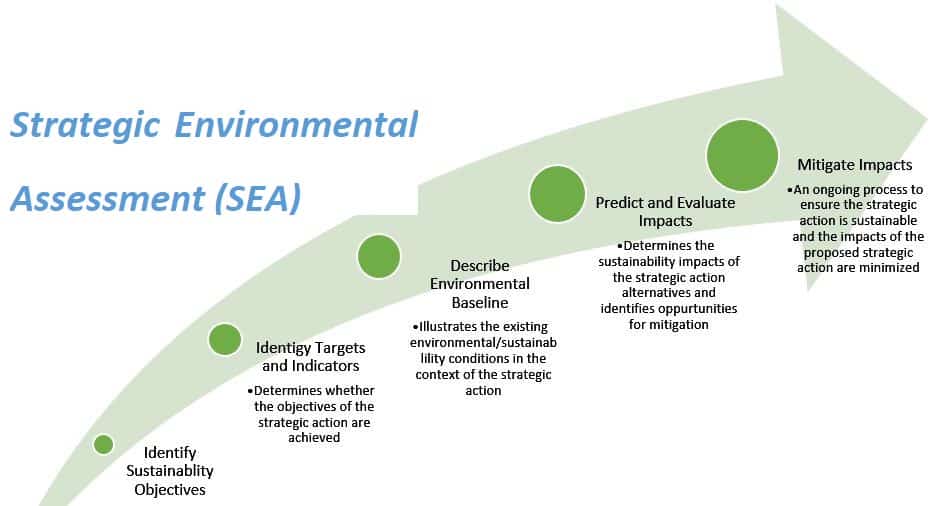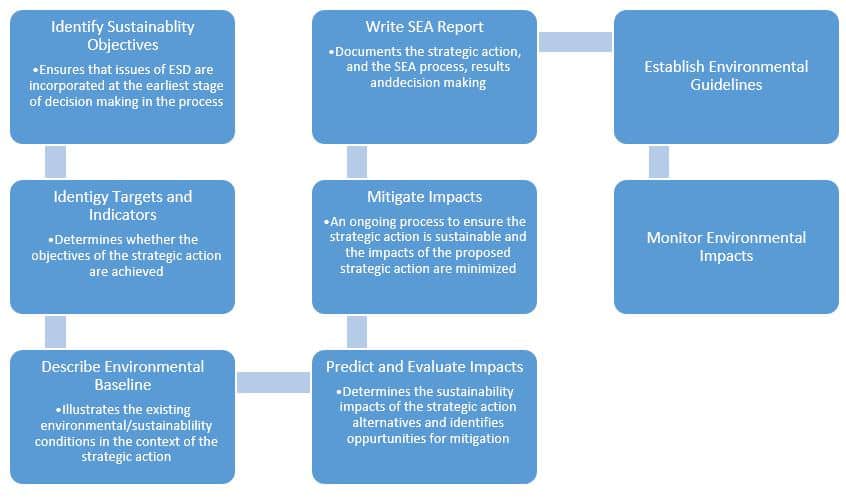History
The widespread adoption of Strategic Environmental Assessment (SEA) procedures is inextricably linked to an increased understanding of the relationship between development and environment, which has undergone profound change since the beginning of the modern environmental movement in the 1960s and 1970s. The need to integrate environmental considerations with development was firmly established by the Brundtland report and became part of World Bank Policy in 1987. The 1992 UNCED Earth Summit, the Rio Declaration and Agenda 21 provided further impetus for national governments to incorporate environmental considerations into all levels of decision making.
In Europe, 1992 proved to be a crucial year for the promotion of SEA. The United Nations’ Economic Commission for Europe (UNECE, 1992) called for the environmental assessment (EA) of PPPs (Policies, Plans and Programmmes) as a means of anticipating and highlighting potential environmental problems, preventing delays and assisting in long term planning, preventing or reducing litigation. It recommended that the results of such Environmental Assessment (EA) be considered on a par with social and economic factors in the development of PPPs. This final point resonated with the plea made by Brundtland.
What is Strategic Environmental Assessment (SEA)?
The concept of SEA and its role in planning and decision making has been given considerable attention in academic literature since the early 1990s. During these years, as the momentum for SEA increased, the way in which it was conceived widened significantly. As analysis of definitions arising from both academic and policy sources reveals the clear rise of two normative claims that have shaped the evolution of SEA to the present day –
- that SEA will contribute to sustainable development;
- that SEA will help improve policy making
Indeed, most SEA definitions refer to it as a process, indicating sustainable development as the ‘end’. Furthermore, the shortcomings in the Environmental Impact Assessment (EIA) process led to the need for a more strategic approach to EA that can be incorporated in the policy, planning and programming level, allowing for a proactive process that will integrate the concept of sustainability much better that Environmental Impact Assessment. SEA is applied at many different levels of strategic activity (e.g. policies, plans and programmes) around the world. It can be applied to a particular geographical area, a particular sector or to a specific issue.
There is a hierarchy of levels in decision making comprising projects, programmes, plans and policies. Logically, policies shape the subsequent plans, programmes and projects that put those policies into practice. Policies are at the top of the decision making hierarchy. As one moves down the hierarchy from policies to projects, the nature of decision – making changes, as does the nature of environmental assessment needed. Policy level assessment tends to deal with more flexible proposals and a wider range of scenarios. Project level assessment usually has well defined and prescribed specifications. SEA promotes social and economic equity and ecological sustainability in development related decisions.
Policies, plans and programmes (PPPs) are more “strategic” as they determine the general direction or approach to be followed towards broad goals. SEA is applied to these more strategic levels. Environmental Impact Assessment is used on projects that put PPPs into tangible effect.
In short, Strategic Environmental Assessment (SEA) is the process of predicting and evaluating the impact of a strategic action on the environment, and using that information in decision-making. SEA is basically environmental impact assessment of strategic actions: policies, plans and programmes.
Difference between EIA and SEA
Environmental impact assessment of projects is the starting point for SEA, but EIA and SEA have some key differences:
Strategic Environmental Assessment of Policies, Plans and Programmes
- Applied to policies, plans and programmes with a broad and long-term strategic perspective.
- Ideally, takes place at an early stage in strategy planning.
- Considers a broad range of alternative scenarios.
- Focus on decision or policy, plan and programme implications for future lower-level decisions.
- Multi – stage, iterative process with feedback loops.
- May not be formally documented.
- Emphasis on meeting balanced environmental, social and economic objectives in policies, plans and programmes. Includes identifying macro-level development outcomes.
- Inherently incorporates consideration of cumulative impacts.
- Focuses on sustainability agenda, gets at sources of environmental deterioration
- Cumulative effects assessment is key to SEA
- Emphasis on meeting environmental objectives, maintaining natural systems
- Broad perspective, lower level of detail to provide a vision and overall framework
whereas EIA of Projects
- Applied to specific and relatively short term (life cycle) projects and their specifications
- Takes place at early stage of project planning once parameters are set.
- Considers limited range of project alternatives.
- Focus on obtaining project permission, and rarely with feedback to policy, plan or programme consideration.
- Well defined, linear process with clear beginning and end (example, from feasibility to project approval).
- Preparation of an EIA document with prescribed format and contents is usually mandatory. This document provides a baseline reference for monitoring.
- Emphasis on mitigating environmental and social impacts of a specific project, but with identification of some project opportunities, off-sets, etc.
- Limited review of cumulative impacts, often limited to phases of a specific project.
- Does not cover regional scale developments or multiple projects.
- Well-defined process, clear beginning and end
- Focuses on standard agenda, treats systems of environmental deterioration
- Narrow perspective, high level of detail
- Considers limited number of feasible alternatives
- Reactive approach to development proposal
Source: UNEP (2002) Environmental Impact Assessment Training Resource Manual, 2nd Edition, UNEP, Geneva. Amended from CSIR (1996)
Limitations of EIA
- EIA takes place once many strategic decisions have already been made, it can often address only a limited range of alternatives and mitigation measures: those of a wider nature are generally poorly integrated into project planning.
- Consultation in EIA is also limited and the contribution of EIA to the eventual decision regarding the project is unclear.
- Although project EIA is widely used and accepted as a useful tool in decision-making, it largely reacts to development proposals rather than proactively anticipating them
- Project EIAs are also generally limited to the project’s direct impacts. This approach ignores a wide range of impacts, including:
- Cumulative impacts: the environmental impacts of multiple plans, projects and other actions
- global impacts: impacts that go beyond the local, project level, for instance climate change
- indirect, secondary or induced impacts: impacts that occur several steps away from the original action, for instance new houses that generate more vehicle movements that increase air pollution that affect the flora in an area
- Synergistic impacts: where impact A + impact B have a total impact of more than A+B: for instance NOx emissions and ozone emissions which together cause smog, which has impacts over and above those of just the NOx + ozone.
Strategic Environmental Assessment can deal with many of these difficulties, as it:
- incorporates environmental issues into project planning and decision making;
- considers alternatives or mitigation measures beyond project level
- involves consultation on more strategic issues
Promotion of sustainable development
- SEA is that it can enhance the integration of environmental concerns in policy and planning processes, thereby helping to implement sustainable development.
- It can help to ensure that environmental and sustainability criteria are fully considered throughout the planning process, for instance in the identification of suitable (or unsuitable) locations for development, and in the assessment of alternative strategic actions.
Technical and Procedural Limitations of SEA
[table id=6 /]
On the technical side the relative lack of case studies and experience of SEA exacerbates these limitations. On the procedural side decision-makers, competent authorities and stakeholders must be aware that Strategic Environmental Assessment is inherently a political process, and should ensure that SEA informs decisions but does not make them.
Strategies and steps for undertaking SEA at the plan or programme level
Many countries and agencies have developed SEA guidelines and procedures. So far, these are mainly aimed at strengthening plan and programme development and are based on an adaptation of the steps characteristics for EIA. Practical experience with these approaches suggest that good practice SEA should involve four stages. Each stage can be further sub-divide into steps/ tasks. But these need not be carried out in sequence.
Basic Stages in SEA
- Establishing the context for the SEA
- Screening
- Setting objectives
- Identifying stakeholders
- Implementing the SEA
- Scoping (in dialogue with stakeholders)
- Collecting baseline data
- Identifying alternatives
- Identifying how to enhance opportunities and mitigate impacts
- Quality assurance
- Reporting
- Informing and influencing decision making
- Making recommendations (in dialogue with stakeholders)
- Monitoring and evaluating
- Monitoring decisions taken on the policies, plans and programmes
- Monitoring implementation of the policies, plans and programmes
- Evaluation of both strategic environmental assessment (SEA) and policies, plans and programmes (PPP)

General Process of Strategic Environmental Assessment

- Identify Sustainability Objectives – Ensures that issues of ESD are incorporated at the earliest stage of decision making in the process
- Identify Targets and Indicators – Determines whether the objectives of the strategic action are achieved
- Describe Environmental Baseline – Illustrates the existing environmental/sustainability conditions in the context of the strategic action
- Predict and Evaluate Impacts – Determines the sustainability impacts of the strategic action alternatives and identifies opportunities for mitigation
- Mitigate Impacts – An ongoing process to ensure the strategic action is sustainable and the impacts of the proposed strategic action are minimized
- Write SEA Report – Documents the strategic action, and the Strategic Environmental Assessment process, results and decision making
- Establish Environmental Guidelines
- Monitor Environmental Impacts
Conclusion
Strategic Environmental Assessment (SEA) is a development planning tool aiming to ensure that environmental, social and economic aspects of sustainability are considered systematically in policies and plans. They address broad strategies issues early in the planning process. As development agencies switch their emphasis from supporting individual projects to providing support for broad policies and strategies, SEAs are becoming more urgent and necessary. Overall, SEA is an integrating approach. In applying SEA, links should be sought with other related approaches to assessment and impact analysis.
Also Read:
- Strategic Environmental Assessment (SEA)
- Urban Environmental Management
- Complete Guide to Strategic Analysis | Meaning, Steps, Types & Examples
- Pillars of Sustainability | Economic, Environmental, and Social
- Qualitative and Quantitative Parameters in Environmental Impact Assessment (EIA)
- Types of environmental pollution
- What is meant by Environmental Education?